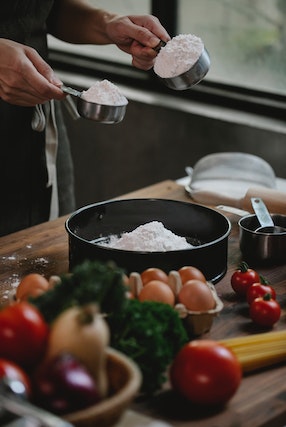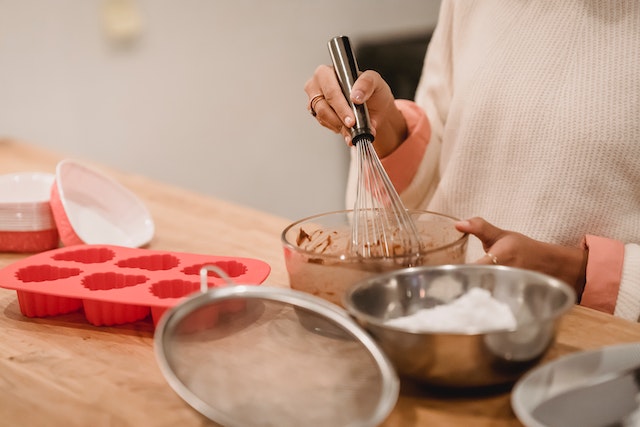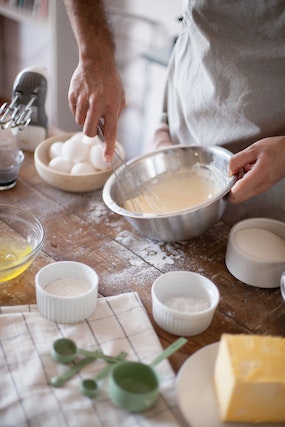
Few endeavors rival the art of baking. Whether it be a decadent double-layered chocolate cake, flaky pastries melting in your mouth, or warm, golden loaves of bread, the allure of creating something sublime from humble ingredients is irresistible. Yet, hidden beneath the delicate sheen of mastery, baking harbors a well-guarded secret: the lurking presence of mishaps that can strike without warning.
For many budding bakers, the journey begins innocently enough. Armed with an arsenal of mixing bowls, measuring spoons, and a culinary enthusiasm that borders on obsession, they dare to tread the sacred path of the pastry chef. Guided by countless online tutorials and dog-eared recipe books, they believe they are equipped with the knowledge to conquer any baking challenge.
But as every seasoned baker knows, a simple deviation from a recipe, a momentary lapse of attention, or an unpredictable twist of fate can quickly turn a kitchen into a battlefield strewn with the remnants of baking mishaps. It is at these moments that the true mettle of a baker is tested, their resilience and creativity pushed to the limits.
Understanding Common Baking Mishaps
The Fickle Nature of Leavening Agents
Baking soda, baking powder, yeast – these mystical substances hold the power to transform your baked goods into fluffy clouds of deliciousness. However, their delicate balance can be disrupted with the slightest misstep, resulting in flat or deflated creations. Forgetting to add the leavening agent, using expired ingredients, or miscalculating the required measurements can ruin your dreams of rising perfection. Remember, precision is key when dealing with these temperamental entities. Double-check your ingredients, mind your expiration dates, and remain vigilant every step of the way.
The Temptation of Thickening Agents
As every chef knows, the art of thickening sauces and fillings can elevate a dish to new heights. Yet, the overzealous use of thickening agents, such as cornstarch or flour, can quickly turn your velvety masterpiece into a gloopy mess. Patience and moderation are essential in achieving the desired consistency. Take care to mix your thickening agent with liquid before adding it to the mixture, and remember that adding a little at a time is often more effective than dumping it all in at once.
The Perils of Oven Dependency
Ah, the oven – the heart and soul of any baker’s domain. However, this seemingly trusty ally can quickly become your worst enemy if not treated with the utmost caution. An oven that runs too hot or too cold can wreak havoc on your delicate creations. Invest in an oven thermometer to ensure accuracy, and always preheat the oven thoroughly before adding your precious batter or dough. Keep a watchful eye, for a few minutes too long can turn a moist cake into a dry nightmare.

When Sugar Turns Sour
Speaking of nightmares, let us not forget the treacherous nature of sugar. The sweetest ally in the baking world can turn sour without warning, leading to disastrous results if not handled with care. The art of caramelization, a delicate dance between heat and sugar, can quickly spiral into a burnt catastrophe if left unattended.
The simple act of melting sugar can transform from a mesmerizing symphony of amber hues to a smoke-filled kitchen in the blink of an eye. Keep a watchful eye as the sugar melts, swirling gently with a heatproof spatula to ensure even distribution of heat.
Texture and Consistency Problems
A successful bake not only relies on taste but also on texture and consistency. The perfect cake should be moist, the cookies should have a delightful crunch, and the bread should be tender and springy. Yet, even the most experienced bakers can find themselves facing unexpected texture and consistency problems that can leave them scratching their heads.
The Case of the Leaden Loaf: Baking bread is an ancient art that requires patience and precision. However, sometimes, despite following the recipe to the letter, the end result can be a disappointingly heavy and dense loaf. This culinary conundrum can often be traced back to the improper proofing of the dough. Yeast, the magical leavening agent responsible for the bread’s rise, needs a warm environment to work its magic. If the dough doesn’t rise adequately, it can result in a heavy, brick-like bread. Ensure that you give your dough enough time to rise, allowing it to reach its full potential.
Cookies That Spread Too Thin: There’s nothing quite as disheartening as pulling out a tray of cookies from the oven, only to find that they’ve spread into one giant, flat mess. This common mishap can be attributed to a variety of factors, including improper ratios of fats, sugar, and flour, as well as a dough that is too warm. To avoid this misfortune, try chilling your dough for at least 30 minutes before baking. This will help the fat solidify and create a sturdier structure, preventing excessive spreading.
Gummy Middle Syndrome: Picture this: you bake a beautiful cake, golden and aromatic, only to cut into it and find a dense, gummy middle. What went wrong? One likely culprit is overmixing the batter. When you vigorously beat the batter, you activate the gluten present in the flour, resulting in a dense and chewy texture. To prevent gummy middle syndrome, gently fold in the dry ingredients and mix just until combined. It’s okay if there are a few lumps; they will disappear during baking, leaving you with a perfectly tender crumb.

Crumbly Disasters: While some desserts are intended to crumble, like a buttery shortbread, others should have a lovely, cohesive texture. If your bars or cakes crumble into a mess at the slightest touch, it’s an indication of not enough binding ingredients.
Consider adding an extra egg, a spoonful of yogurt, or a bit more fat to provide the structure needed to hold everything together. Additionally, ensure that you’re baking your dessert for the appropriate amount of time. Underbaking can result in a crumbly mess, while overbaking can make your creation dry and prone to crumbling.
Baking, much like life itself, can be a series of trial and error. Mishaps and failures are inevitable, but they shouldn’t deter you from continuing on your culinary journey.
Flavor and Aesthetic Issues
- The Vanishing Flavors: Have you ever anticipated the rich aroma and burst of flavor that a recipe promised, only to be left disappointed by a lackluster outcome? This baffling phenomenon can occur when ingredients fail to meld together harmoniously or when the balance between sweet, savory, salty, and tangy is thrown off. To elevate your creations, consider adding a touch of acidity, such as lemon juice or vinegar, to brighten flavors or sprinkle a pinch of sea salt to enhance the sweetness. Don’t be afraid to experiment and adjust seasonings to suit your taste preferences.
- The Dull and Lifeless Palette: Baking is not just about tantalizing taste buds; it’s also an opportunity to create visually stunning treats. But sometimes, despite your best efforts, your creations may fall flat in the aesthetic department. Is it a cake without the perfect crumb, or a bread lacking a golden crust?

Enhancing the visual appeal of your baked goodies can be as simple as investing in quality ingredients, properly measuring flour, and skillfully decorating with colorful fruit, edible flowers, or a dusting of powdered sugar. Remember, presentation is the gateway to temptation!
- Burnt Offerings: The tantalizing aroma of your baked goods wafting through the house can quickly turn into an acrid smell of disappointment if you allow your treats to linger in the oven for a moment too long. Burnt edges or tops can be disheartening after hours of laborious effort. Keep a close eye on your baking creations and rely on the tried-and-true method of inserting a toothpick into the center to gauge doneness. Remember, there is a fine line between caramelization and carbonization, so practice patience and remove your delights from the oven just as they reach perfection.
- The Case of the Soggy Bottoms: The quest for the perfect pastry crust can sometimes end in frustration when an unappealing soggy bottom steals the spotlight. Avoid this culinary calamity by employing various techniques like blind baking – pre-baking your crust before adding the filling – or brushing an egg wash on the bottom to create a barrier that prevents moisture from seeping in. By mastering the art of a crisp, golden crust, you can elevate any dessert to delectable heights.
- The Elusive Marbling Effect: Swirls of contrasting colors running through a cake or a cheesecake can add a touch of artistic magic to your creations. Achieving the coveted marbling effect, however, requires a delicate touch and a keen eye. Overmixing or undermixing the batters can result in muddled colors and a lost opportunity for visual splendor. Use a skewer or the tip of a knife to gently swirl the batters together, making sure not to overwork them. Let the flavors intermingle and dance to create a spectacular aesthetic treat.
Remember, the road to baking mastery is paved with challenges, and flavor and aesthetic issues are no exception. Embrace the imperfections as opportunities for growth and artistic expression. With every mishap, you gain valuable insights that will allow you to create truly extraordinary culinary marvels.
Problematic Ingredients and Substitutions
In the world of baking, there are certain ingredients that can prove to be quite problematic if not handled with care. From substitutions gone wrong to unexpected reactions, these ingredients can throw even the most seasoned bakers off their game. Here, we explore some of these culinary conundrums and offer tips on how to navigate through them.
The Enigma of Eggs
Eggs, with their myriad functions in baking, are an essential ingredient that can’t be easily replaced. However, for those with dietary restrictions or allergies, finding suitable substitutes becomes a necessity. While there are alternatives like applesauce, mashed bananas, or flaxseed meal mixed with water, it’s crucial to understand that these substitutions can alter the texture and taste of your end product. Experimentation and careful observation are key.

Remember that the binding, leavening, and moisturizing properties of eggs are not easily replicated, so be prepared for some trial and error.
The Gluten-Free Challenge
For individuals on a gluten-free diet, a whole new world of baking alternatives opens up. While there are now numerous gluten-free flours available, adapting traditional recipes can still be tricky. Gluten, a protein found in wheat, provides structure and elasticity to baked goods. Without it, achieving the same texture and consistency can be a challenge. Combining different gluten-free flours, such as rice flour, almond flour, and tapioca flour, can help mimic the desired texture. However, be prepared for some experimentation as ratios may need to be adjusted. Additionally, incorporating xanthan gum or guar gum can improve the binding properties of gluten-free flours.
The Sugar Dilemma
Reducing or replacing sugar in baking can be a double-edged sword. While some people opt for healthier sweeteners or sugar alternatives, it’s important to consider the impact on texture and moisture content. Sugar not only sweetens baked goods but also contributes to their tenderness and moistness. Substituting sugar can result in a drier, crumblier product. If you do decide to use an alternative sweetener, it’s essential to follow baking recipes specifically tailored for those ingredients. However, embrace the challenge and experiment with natural alternatives like honey, maple syrup, or agave nectar to discover unique flavors and textures.
The Butter vs. Margarine Debate
The choice between butter and margarine can be a heated topic in the baking world. Butter, with its rich flavor and natural fat content, is often the preferred choice for its impact on taste and texture. For those who prefer or require a dairy-free option, margarine can serve as a substitute. However, it’s essential to select a margarine suitable for baking, as some varieties may contain a higher water content, which can affect the structure and texture of the final product. Additionally, remember that margarine often contains additives that alter its flavor, so taste test and adjust your recipe accordingly.
Prevention and Troubleshooting Resources
In the world of baking, mishaps are bound to happen. However, with a little preparation and the right resources, you can minimize the likelihood of disasters and overcome any baking challenges that come your way. Here are some prevention and troubleshooting resources that every baker should have in their arsenal:
1. Recipe Research: Before attempting a new recipe, take the time to research it thoroughly. Read reviews from other bakers who have tried the recipe and see if they offer any tips or suggestions. Look for any common problems or pitfalls that others have encountered and learn from their experiences.

2. Baking Books and Websites: Invest in a few trusted baking books or bookmark reliable baking websites that offer detailed instructions, tips, and troubleshooting advice. These resources often include step-by-step guides, precise measurements, and variations for different ingredients or methods.
3. Baking Classes: Consider enrolling in baking classes or workshops to sharpen your skills and learn from experienced bakers. Not only will you gain valuable knowledge, but you’ll also have the opportunity to ask questions and receive hands-on guidance.
4. Baking Ambassadors: Connect with fellow bakers, either through online forums or local baking groups, who can offer support and advice. Baking ambassadors can act as a sounding board for troubleshooting, provide suggestions for alternative techniques, and share their own personal experiences with baking mishaps.
5. Ingredient Substitution Charts: Keep a handy reference guide or bookmark an online resource that outlines ingredient substitutions. This can be especially useful if you run out of a particular ingredient mid-bake or need to adjust a recipe to accommodate dietary restrictions or allergies.
6. Kitchen Tools: Having the right kitchen tools can make a significant difference in your baking success. Invest in quality measuring cups, spoons, an oven thermometer, and a reliable kitchen scale. These tools will help ensure accurate measurements, proper oven temperatures, and consistent results.
7. Organization and Preparation: Before embarking on a baking project, gather all the necessary ingredients and equipment. Read through the recipe carefully and ensure you have everything on hand. Mise en place, the practice of prepping and organizing all ingredients before baking, can help prevent mistakes and ensure a smoother baking process.
8. Practice, Patience, and Persistence: Remember that baking is as much a science as it is an art. It takes practice, patience, and persistence to become a skilled baker. Don’t be disheartened by the occasional mishap or failed attempt. Learn from your mistakes, adapt your techniques, and keep experimenting.
With these prevention and troubleshooting resources at your disposal, you’ll be well-equipped to handle any baking mishaps that come your way. Embrace the challenges, stay curious, and never lose sight of the joy that comes from creating something delicious out of humble ingredients. Happy baking, fellow adventurers!
